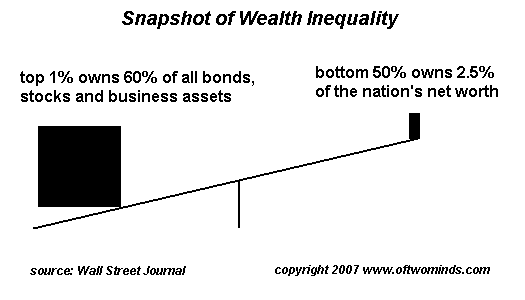

|
| weblog/wEssays archives | home | |
|
Wealth Distribution (January 16, 2007) My entry on wealth and kleptocracy drew two worthy responses. Frequent contributor Michael Goodfellow gently suggested that presenting data to back up my assertions about higher tax rates in the 50s would have strengthened my case, and I agree; I'm working on assembling some income and wealth distribution data. Here is my first presentation of one well-known nation's wealth distribution: 
Astute reader Jim M. sent in this response to my query, "Could someone explain the difference between the kleptocracy in Iraq and the African kleptocracies so roundly criticised in the West?" There is a story (probably apocryphal) of an African potentate who visits a Japanese politician's luxurious home and asks, "How can you afford this on your government salary?" In response to which the Japanese points out through the window and replies, "See that expressway out there?"Well put, Jim. Which brings us to the chart above. I think it fair to say that one key gray area is the expectations of a nation's populace and their perceptions of fairness and the opportunity of those in the bottom half to join the top 1% which owns the vast majority of the nation's wealth-producing assets. What nation does this chart describe? Guess carefully. It is a large nation, not some sliver of a country with 5 million people. Here is another factoid about that nation's wealth and income distribution: one of the nation's largest companies, with 234,600 fulltime employees, recently set aside $30 million to reward those 234,600 workers for customer service. The company's chief, meanwhile, earned $240 million over the past 6 years, and recently walked away with another $210 million. That's a total of $450 million in "compensation," or 10,000 times the nation's median household income. Here's another clue: Corporate profits jumped 21.3 percent in 2005 to $1.35 trillion. Profits have been boosted by strong productivity gains and low wage growth, and now account for their largest share of national income in 40 years -- 11.6 percent. The share that went to wage and salary earners, however, sank to 56.9 percent in the fourth quarter -- a 40-year low. And one final clue: The folks at the top of the income heap in the mystery nation each "earned" a staggering 8,000 times as much as the median family income. Did you say Brazil? China? India? Good guesses, but the answer is the U.S.A. Is this a fair or equitable distribution of wealth? I have no idea, but I suspect it is at odds with what the average American believes about the nation's underlying fairness. Can a poor kid from nowhere rise up to Wall Street's pinnacle and "earn" $360 million a year? Perhaps. But the question also arises, should anyone "earn" $360 million for producing nothing, creating no new product or service, coming up with no innovation, etc.? The shades of gray are getting darker, as I think the data suggest. Here are the sources: Wealthiest American Families Add To Their Share of U.S. Net Worth (Wall Street Journal) In 2004, the wealthiest percent owned 70% of bonds, 51% of stocks and 62.3% of business assets. Families in the bottom half saw their share fall to 2.5% of net worth in 2004 from 2.8% in 2001. Profits surge to 40-year high (Marketwatch.com) From the U.S. census Bureau: After falling for five years, inflation-adjusted median household income rose 1.1%, to $46,326.Barrons Up and Down Wall Street (Dec. 11, 2006): Fred Hickey, proprietor of the wonderful High-Tech Strategist and member of the Barron's Roundtable, muses on the disconnect between Wall Street and the real world, like Nashua, which he calls home. The differences have never been greater, he laments, and the wealth disparity is at the highest level in history. By way of illustration, he cites the fact that the average pay of the top 126 hedge fund managers last year was $363 million, up some 45% from the year before.Divide $360 million by $46,000 and there you have it. No place like Home Depot (SF Chronicle, Jan. 14, 2007) Why Income Inequality Matters (yahoo.com) And for a skeptical take, here is an article forwarded by Michael Goodfellow: The Income Gap's Credibility Gap (Reason Magazine, Jan. 15, 2007) For more on this subject and a wide array of other topics, please visit my weblog. copyright © 2007 Charles Hugh Smith. All rights reserved in all media. I would be honored if you linked this wEssay to your site, or printed a copy for your own use. |
||
| weblog/wEssays | home |